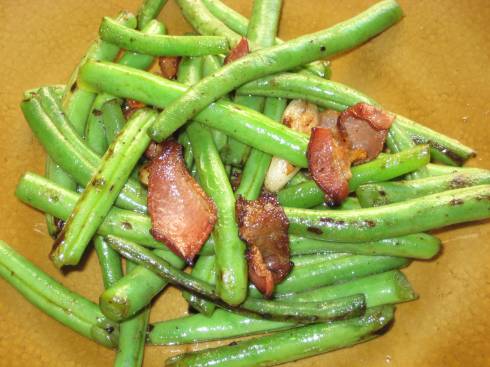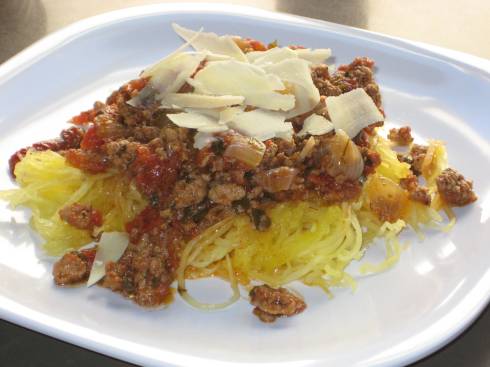You are currently browsing the category archive for the ‘Vegetables’ category.
My daughter is a year and a half old now and has become a picky eater. Unlike her infant days where she eagerly gobbled up any type of baby food I made her, she is much choosier about what she will try. The likeliest target to end up on the floor is vegetables. Even the ones she will eat today will not get the same treatment tomorrow. So to make these green beans more enticing, I cooked it with bacon. Because, let’s face it, everything tastes better with bacon. And the bacon I had on hand was one I purchased from Applegate Farms’ website. I got a discount by purchasing a case over individual packages.
Garlicky Green Beans and Bacon
1 pound of green beans, washed and trimmed
4 pieces uncooked bacon, chopped
5 cloves garlic, chopped
salt to taste
approximately 1/4 cup water
- Over high heat, cook bacon pieces until some of the fat is rendered. I used a wok but a cast-iron skillet or saute pan will work, too.
- Add the green beans and garlic and continue to cook for a few minutes, stirring frequently.
- Add the water, in increments if necessary, while still cooking over high heat to create steam. If the pan is not hot enough, you’ll end up stewing the beans.
- Season with salt and remove the beans once they are cooked through but still crunchy and bright green.
I served these along side the rib eye steaks I wrote about previously and it was a simple and satisfying meal. Best of all, my daughter started off by eating the green beans before she had any of the steak, and my little meat eater loves steak. I was super excited and looked at my husband who said matter of factly, “Of course she likes it, it tastes like bacon.” So eloquently put. The excitement was short lived, though, as I found moments later that bits of green beans were the only things left in her bowl with no trace of bacon or beef.
Sigh… I’ll keep trying.
Spaghetti and I have a history together. As a kid, I loved to eat spaghetti. I loved to twirl the noodles around my fork or slurp it a la “Lady and the Tramp”. I didn’t care that my mom added soy sauce to the marinara or that the cheese came from a green shaker can. It was fun to eat. Then when I got older and was in school, it was a quick food to make and was easy on the grocery bill. Those frequent quick and easy meals led to the freshman 15 and the sophomore who-knows-how-many. Once the Atkins diet and low-carb meals became popular, I said goodbye to my spaghetti as I prepared to fit into my wedding dress.
Now we’ve reunited and spaghetti is once again part of my culinary circle. I’ve figured out I can have my spaghetti without the pasta thanks to a very aptly named gourd – spaghetti squash. It’s as if mother nature knew that there would be those who love Italian but not wheat and provided the perfect solution. Once cooked, the spaghetti squash is ready to carry any sauce with its long strands. It is so simple to prepare, you’ll wish you switched your semolina for squash ages ago.
The easiest way to cook spaghetti or any other squash (acorn, pumpkin, etc.), is to roast it whole. I learned this tip from The Spunky Coconut Cookbook: Gluten Free, Casein Free, Sugar Free (page 59, How to Cook a Pumpkin or Squash). There are step-by-step instructions and photos and it’s hard to mess up. You skip all the work needed to cut into a hard gourd not to mention that squashy residue that doesn’t want to wash off your hands. Just stick it in the oven and once it’s brown and soft, the squash can be peeled and seeded. In case you don’t have the cookbook, here are some instructions.
Roasting a Whole Spaghetti Squash
- Preheat oven to 350 to 400 degrees F.
- Place a clean squash, uncut, in a baking dish or roasting pan.
- Bake for an hour or more depending on the size of the squash. The skin will turn brown and slightly puffy.
- Let squash cool before peeling. Cut in half and remove the seeds.
- Use a fork to scrape and separate the strands.
My small to medium spaghetti squash was cooked at 350 degrees F for about an hour and ten minutes. Once it was done, this is what I had.
The spaghetti squash is tender but has enough bite to simulate an al dente texture. It makes a great bed for your favorite sauce and meatballs. This is how we enjoy spaghetti now and my daughter is learning how to twirl it around her fork. Then she throws the fork aside and digs in with both hands.
What will you put on your spaghetti squash?





